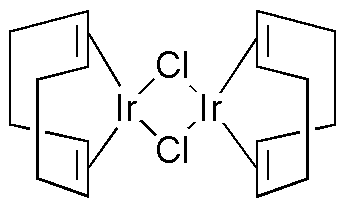Bis(1,5-cyclooctadiene)diiridium(I) dichloride is widely utilized in research focused on:
- Catalysis: This compound serves as a catalyst in various organic reactions, enhancing reaction rates and selectivity. Its unique structure allows for efficient catalysis in processes such as hydrogenation and hydroformylation.
- Material Science: It is used in the development of advanced materials, particularly in creating iridium-based polymers that exhibit unique electronic properties, making them suitable for applications in organic electronics.
- Pharmaceutical Chemistry: Researchers leverage this compound in drug synthesis, where it can facilitate the formation of complex organic molecules, streamlining the development of new pharmaceuticals.
- Environmental Chemistry: The compound is explored for its potential in catalytic converters, helping to reduce harmful emissions in automotive applications by converting pollutants into less harmful substances.
- Research and Development: Its unique properties make it a valuable tool in academic research, particularly in studies focused on coordination chemistry and the development of new catalytic systems.
General Information
Properties
Safety and Regulations
Applications
Bis(1,5-cyclooctadiene)diiridium(I) dichloride is widely utilized in research focused on:
- Catalysis: This compound serves as a catalyst in various organic reactions, enhancing reaction rates and selectivity. Its unique structure allows for efficient catalysis in processes such as hydrogenation and hydroformylation.
- Material Science: It is used in the development of advanced materials, particularly in creating iridium-based polymers that exhibit unique electronic properties, making them suitable for applications in organic electronics.
- Pharmaceutical Chemistry: Researchers leverage this compound in drug synthesis, where it can facilitate the formation of complex organic molecules, streamlining the development of new pharmaceuticals.
- Environmental Chemistry: The compound is explored for its potential in catalytic converters, helping to reduce harmful emissions in automotive applications by converting pollutants into less harmful substances.
- Research and Development: Its unique properties make it a valuable tool in academic research, particularly in studies focused on coordination chemistry and the development of new catalytic systems.
Documents
Safety Data Sheets (SDS)
The SDS provides comprehensive safety information on handling, storage, and disposal of the product.
Product Specification (PS)
The PS provides a comprehensive breakdown of the product’s properties, including chemical composition, physical state, purity, and storage requirements. It also details acceptable quality ranges and the product's intended applications.
Certificates of Analysis (COA)
Search for Certificates of Analysis (COA) by entering the products Lot Number. Lot and Batch Numbers can be found on a product’s label following the words ‘Lot’ or ‘Batch’.
Numéro de catalogue
Numéro de lot/série
Certificates Of Origin (COO)
This COO confirms the country where the product was manufactured, and also details the materials and components used in it and whether it is derived from natural, synthetic, or other specific sources. This certificate may be required for customs, trade, and regulatory compliance.
Numéro de catalogue
Numéro de lot/série
Safety Data Sheets (SDS)
The SDS provides comprehensive safety information on handling, storage, and disposal of the product.
DownloadProduct Specification (PS)
The PS provides a comprehensive breakdown of the product’s properties, including chemical composition, physical state, purity, and storage requirements. It also details acceptable quality ranges and the product's intended applications.
DownloadCertificates of Analysis (COA)
Search for Certificates of Analysis (COA) by entering the products Lot Number. Lot and Batch Numbers can be found on a product’s label following the words ‘Lot’ or ‘Batch’.
Numéro de catalogue
Numéro de lot/série
Certificates Of Origin (COO)
This COO confirms the country where the product was manufactured, and also details the materials and components used in it and whether it is derived from natural, synthetic, or other specific sources. This certificate may be required for customs, trade, and regulatory compliance.


